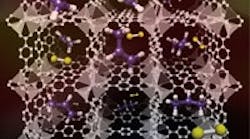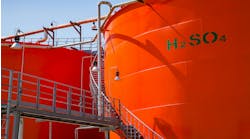According to market information experts IHS, Englewood, Colo., process catalysts are a $13-billion/yr business worldwide that underpins the output of petroleum products, chemicals, pharmaceuticals, synthetic rubbers and plastics and other materials worth upwards of $600 billion/year. At the same time, about 90% of chemical manufacturing processes and more than 20% of all industrial products rely on catalytic steps.
[pullquote]
As the vast majority of catalysts are heterogenous, much time, effort and money has been, and continues to be, invested in understanding how they work. So today's catalytic reactors are optimized by modeling the relationships between factors such as heat transfer, fluid dynamics and surface reaction kinetics.
Because temperature control is essential to the optimal operation of such reactors, temperature maps are an extremely valuable guide to what's really going on inside the units. However, probing the temperature of a gas inside a reactor without disturbing its flow is difficult — particularly when mapping the physical parameters and gradients that dictate heat and mass flow and catalytic efficiency.
UCLA researchers measured the heat generated in a propylene-to-propane reaction without perturbing the flow in the micro-reactor by using an MRI technique. Source: Nanette Jarenwattananon, Yuebiao Zhang, Louis Bouchard; UCLA Chemistry.
For example, nuclear magnetic resonance thermometry can measure temperature non-invasively, but traditional approaches applied to gases produce signals that depend only weakly on temperature, are rapidly attenuated by diffusion, or require contrast agents that may interfere with reactions.Consequently, accurate imaging has been an omnipresent technical challenge. However, according to a recent report in Nature, chemists at the University of California Los Angeles (UCLA) have for the first time used magnetic resonance imaging (MRI) — a technique normally reserved for peering inside the human body — to look inside a catalytic reactor and better measure the temperature at the gas/solid interface where gases make contact with a solid catalyst.The research, a major step toward bridging the gap between laboratory studies and industrial catalysis, could help improve the design and environmental impact of catalytic reactors. "The new method is important because an overwhelming majority of chemical industry products are made using heterogeneous catalysts functioning at the gas/solid interface," says the study's senior author, Louis Bouchard, an assistant professor of chemistry and biochemistry and a member of UCLA's California NanoSystems Institute.Under the leadership of Bouchard, UCLA chemistry graduate student researcher Nanette Jarenwattananon and her colleagues applied magnetic-field gradients — which are normally used to generate density images in MRI — across a catalytic reactor as a means to spatially encode the temperature of the gas. Warmer molecules move faster, leading to longer-lived magnetic resonance signals, while signals from colder molecules decay more rapidly.The researchers also demonstrated micro-scale MRI images in a micro-reactor using parahydrogen, a state of the hydrogen molecule in which the nuclei are aligned in opposite directions. During the chemical reaction they studied — the hydrogenation of propylene to propane — parahydrogen is part of the propane molecule and is converted into observable nuclear magnetism to enhance the MRI signal."The ability to follow the reaction in a micro-reactor will help engineers and chemists design better lab-on-a-chip devices, which are increasingly used in pharmaceutical synthesis and industrial catalytic reactions," Bouchard notes.Catalytic micro-reactors may provide green chemistry alternatives — less chemical waste, lower cost and minimal energy waste — to conventional, industrial-sized reactors because they make it easier to control the chemical-reaction conditions and operate closer to optimal conditions. The research, funded by the National Science Foundation, was carried out in collaboration with Omar M. Yaghi, a professor of chemistry at the University of California, Berkeley, Berkley, Calif., to demonstrate the methodology on new, emerging catalysts based on metal organic frameworks, which are projected to be ideal platforms for lab-on-a-chip catalysis at the micro-scale. For more on such catalysts, see, e.g., "Porous Nanonstructure Boosts Selectivity," and "MOFs Get Tryout."



